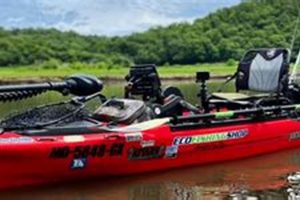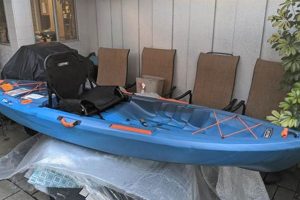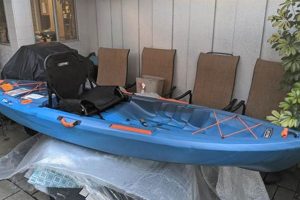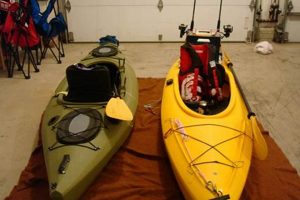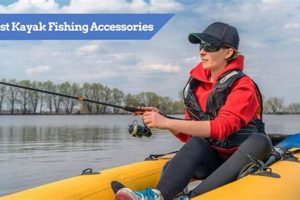Equipping a kayak for angling in open waters involves selecting specialized gear designed to enhance safety, improve fishing success, and manage equipment effectively. This might include items like rod holders, fish finders, anchors, specialized paddles, and storage solutions adapted to the marine environment. For instance, a kayak angler might utilize a GPS-enabled fish finder to locate productive fishing grounds, paired with a drift chute anchor for maintaining position in currents.
Effective offshore kayak angling requires careful consideration of the unique challenges presented by the open ocean. Properly chosen equipment enhances safety through improved stability and navigation. It also increases fishing effectiveness by providing anglers with the tools needed to locate, catch, and handle fish in this dynamic environment. Historically, ocean kayak fishing has evolved from a niche activity to a popular pursuit, driven by advancements in kayak design and specialized gear. These developments allow anglers to venture farther offshore and target a wider range of species.
This article will explore various aspects of equipping kayaks for offshore fishing, including recommended gear choices, safety considerations, and techniques for effective use. It will also delve into the different types of kayaks suited for ocean fishing and the specific challenges they address.
Essential Tips for Offshore Kayak Angling
Proper preparation and equipment selection are crucial for safe and successful offshore kayak fishing. The following tips offer guidance for enhancing both safety and fishing effectiveness in the open ocean environment.
Tip 1: Prioritize Safety Equipment: Always wear a personal flotation device (PFD) and carry essential safety gear, including a VHF radio, signaling devices (flares, whistle), and a first-aid kit. A leash connecting the paddle to the kayak prevents loss in rough conditions.
Tip 2: Choose a Suitable Kayak: Select a kayak designed for stability and performance in offshore waters. Longer kayaks generally offer better tracking and speed, while wider kayaks provide increased stability.
Tip 3: Secure Gear Properly: Use appropriate mounts and leashes to secure all equipment to the kayak. This prevents loss of valuable gear in the event of a capsize and maintains a clutter-free deck for safe movement.
Tip 4: Plan for Navigation and Communication: Carry a chart, compass, or GPS device for navigation, and ensure a charged VHF radio is readily accessible for communication in emergencies. Familiarize oneself with local regulations and boating traffic patterns.
Tip 5: Employ Appropriate Anchoring Techniques: Utilize a drift chute or sea anchor to control drift in currents or wind. Practice deploying and retrieving the anchor system before venturing offshore.
Tip 6: Select Specialized Fishing Gear: Equip the kayak with rod holders, fish finders, and tackle storage solutions designed for the marine environment. Consider using saltwater-resistant reels and lines.
Tip 7: Monitor Weather Conditions: Check marine weather forecasts before embarking on any offshore kayak fishing trip. Be prepared to adjust plans or return to shore if conditions deteriorate.
By adhering to these guidelines, anglers can significantly enhance their safety and overall enjoyment while kayak fishing in the open ocean. Proper preparation and equipment choices contribute to a more successful and rewarding experience.
This information provides a solid foundation for planning and executing safe and productive offshore kayak fishing trips. Further research into specific techniques and local regulations is encouraged.
1. Rod Holders
Rod holders are integral components within the broader context of ocean kayak accessories for fishing. They provide secure storage and quick access to fishing rods, enabling anglers to manage lines, change lures, and handle fish efficiently while maintaining kayak stability. Proper rod holder selection and placement are crucial for optimizing fishing performance and safety in the dynamic offshore environment.
- Types and Mounting Options
Various rod holder types exist, including flush-mount, adjustable, and rotating models. Flush-mount holders offer a streamlined profile but limited adjustability. Adjustable holders allow anglers to change rod angles, while rotating holders facilitate trolling and maneuvering. Selecting the appropriate type and mounting location depends on the kayak’s design, target species, and fishing techniques employed.
- Material and Construction
Rod holders are typically constructed from durable materials such as marine-grade stainless steel, aluminum, or high-impact plastic. Corrosion resistance is crucial in saltwater environments. High-quality construction ensures longevity and reliable performance under demanding conditions.
- Placement and Ergonomics
Strategic rod holder placement enhances fishing efficiency and safety. Positioning holders within easy reach allows for effortless rod retrieval and stowage without compromising balance. Considerations include the angler’s paddling stroke, kayak stability, and the need to maintain a clear deck space.
- Integration with Other Accessories
Rod holders often integrate with other kayak fishing accessories, such as fish finders and tackle storage systems. This integration creates a streamlined and efficient fishing platform. For example, positioning rod holders near a fish finder screen allows anglers to monitor sonar readings while simultaneously managing fishing rods.
Effective rod holder selection and placement contribute significantly to the overall success and safety of ocean kayak fishing. By carefully considering these factors, anglers can optimize their fishing experience and focus on the pursuit of target species in the challenging offshore environment. A well-organized kayak, equipped with appropriate rod holders, allows for efficient gear management and enhances the angler’s ability to respond quickly to changing conditions and fish activity.
2. Fish Finders
Fish finders represent a critical component within the ocean kayak accessories fishing domain. These electronic devices utilize sonar technology to locate fish and map underwater structures, providing anglers with crucial information for increasing fishing success. The cause-and-effect relationship between fish finder utilization and catch rates is well-established. By accurately identifying fish concentrations and bottom contours, anglers can strategically position their kayaks and deploy lures or bait with greater precision. For example, locating a thermocline or a school of baitfish near a reef structure significantly increases the probability of encountering predatory game fish. This informed approach contrasts sharply with less effective methods, such as random drifting or blind casting, which often yield lower success rates. The practical significance of this understanding lies in the angler’s ability to maximize fishing time and effort by focusing on high-potential areas.
Several factors influence fish finder effectiveness in the context of ocean kayak fishing. Kayak stability plays a significant role, as excessive rocking or movement can distort sonar readings. Furthermore, transducer placement and mounting angle require careful consideration to ensure accurate data acquisition. Transducers mounted too close to the kayak’s hull or at an incorrect angle may generate spurious readings or fail to detect fish effectively. Understanding these nuances allows anglers to optimize fish finder performance and interpret data accurately. Advanced features, such as GPS integration and chartplotting capabilities, further enhance the fish finder’s utility by enabling precise navigation and waypoint marking of productive fishing grounds. This integration of technologies streamlines the entire fishing process, from initial location scouting to repeated targeting of specific areas.
In summary, integrating a fish finder into an ocean kayak fishing setup offers significant advantages. It empowers anglers to make informed decisions regarding kayak positioning, lure selection, and fishing strategy. This informed approach maximizes fishing efficiency and increases the probability of success in the challenging offshore environment. Understanding the principles of sonar technology, transducer placement, and kayak stability, alongside leveraging advanced features such as GPS integration, represents a crucial step towards maximizing the benefits of fish finders in ocean kayak angling. Overcoming the challenges associated with accurate data interpretation and effective equipment integration ultimately leads to a more rewarding and productive fishing experience.
3. Safety Gear
Safety gear constitutes a critical aspect of ocean kayak accessories for fishing. The inherent risks associated with open water environments necessitate meticulous preparation and the utilization of appropriate safety equipment. Prioritizing safety enhances angler well-being and allows for a more focused and enjoyable fishing experience. Neglecting safety precautions can lead to adverse outcomes, ranging from minor inconveniences to life-threatening situations.
- Personal Flotation Devices (PFDs)
PFDs are fundamental safety items for any kayak angler. They provide buoyancy in the event of capsize, increasing survival chances in challenging conditions. Selecting a comfortable, well-fitting PFD designed for kayaking ensures unrestricted movement and efficient paddling. Inflatable PFDs offer greater freedom of movement but require regular maintenance and inspection. Automatic inflation mechanisms provide added security in situations where the angler may be incapacitated.
- Communication Devices
Reliable communication is essential in offshore environments. VHF radios enable direct contact with the Coast Guard and other vessels in emergencies. Carrying a waterproof handheld VHF radio, along with a backup communication method such as a satellite messenger or personal locator beacon (PLB), provides redundancy and increases the likelihood of successful communication in distress situations. Regularly testing these devices and familiarizing oneself with proper communication protocols are crucial for effective utilization.
- Signaling Devices
Visual and auditory signaling devices are essential for attracting attention in emergency situations. Flares, whistles, and mirrors can effectively signal distress to other vessels or rescue personnel. Storing these items in a readily accessible and waterproof container ensures they remain functional when needed. Understanding the specific uses and signaling protocols for different devices maximizes their effectiveness.
- First-Aid and Survival Equipment
A well-stocked first-aid kit is crucial for addressing minor injuries and providing essential care until professional medical assistance is available. Including items such as bandages, antiseptic wipes, pain relievers, and seasickness medication addresses common offshore ailments. Supplementing the first-aid kit with survival items like a space blanket, signaling mirror, and emergency rations enhances preparedness for unforeseen circumstances and prolongs survival chances in challenging conditions. Regularly inspecting and replenishing these supplies maintains their effectiveness.
Integrating these safety elements into an ocean kayak fishing setup directly contributes to a safer and more enjoyable experience. These components collectively mitigate risks and provide essential resources for managing emergencies, allowing anglers to focus on fishing with greater peace of mind. The careful selection and regular maintenance of safety gear demonstrate a commitment to responsible angling practices in the demanding offshore environment. While specialized fishing accessories enhance the pursuit of target species, prioritizing safety ensures the angler’s well-being and ability to return safely.
4. Kayak Selection
Kayak selection forms a cornerstone of effective ocean kayak accessories fishing. The vessel itself serves as the foundational platform upon which all other accessories are integrated. A thoughtfully chosen kayak directly influences stability, maneuverability, and overall fishing effectiveness in the demanding offshore environment. Cause and effect relationships exist between kayak characteristics and fishing outcomes. For instance, a kayak with insufficient stability compromises casting accuracy and fish fighting capability, potentially leading to lost catches or even capsize. Conversely, a stable and appropriately sized kayak enhances angler comfort, improves casting precision, and provides a secure platform for battling larger fish. Consider a scenario where an angler targets pelagic species in rough seas. A shorter, less stable kayak significantly hinders performance and compromises safety, whereas a longer, more stable kayak designed for offshore conditions provides the necessary platform for success and angler well-being. Choosing a sit-on-top kayak offers advantages in warmer climates and calmer waters, enhancing angler mobility and simplifying re-entry after a capsize. Sit-in kayaks, while offering greater protection from the elements and increased storage capacity, can present challenges in rough seas and require more advanced self-rescue techniques.
The practical significance of informed kayak selection extends beyond mere comfort and convenience. It directly impacts safety, fishing effectiveness, and the ability to manage diverse ocean conditions. Kayaks designed for offshore fishing typically incorporate features like higher weight capacities, increased storage for fishing gear, and specialized mounting points for rod holders, fish finders, and other accessories. For example, a kayak equipped with integrated rod holders and a spacious storage well streamlines gear management and enhances fishing efficiency. Furthermore, kayaks designed with scupper holes facilitate water drainage, maintaining stability in rough seas. Understanding these design features empowers anglers to make informed decisions aligning with their specific fishing needs and target species. Specialization further refines kayak selection. Anglers targeting large pelagic species require kayaks with exceptional stability and tracking capabilities, whereas anglers pursuing inshore species may prioritize maneuverability and shallower drafts. Matching kayak characteristics to the intended fishing style maximizes performance and overall satisfaction.
In summary, appropriate kayak selection serves as a prerequisite for successful ocean kayak accessories fishing. The kayak’s inherent characteristics directly influence stability, maneuverability, and the ability to integrate essential fishing accessories. Understanding the cause-and-effect relationships between kayak design, fishing techniques, and target species empowers anglers to make informed decisions. Prioritizing kayak selection as a foundational element of the ocean kayak fishing system enhances safety, improves fishing outcomes, and contributes to a more rewarding experience in the challenging offshore environment. Addressing the complexities of kayak selection through careful research and consideration of individual needs and fishing styles ultimately leads to greater success and enjoyment on the water.
5. Paddle Leashes
Paddle leashes represent a critical, often overlooked, component within the ocean kayak accessories fishing ecosystem. A paddle leash acts as a tether, connecting the paddle to the kayak and preventing loss in the event of a capsize, strong currents, or unexpected wave action. While seemingly simple, this connection plays a vital role in angler safety and overall fishing effectiveness in the challenging offshore environment.
- Safety and Security
The primary function of a paddle leash is safety. In the open ocean, losing a paddle can quickly escalate into a dangerous situation. A leash ensures the paddle remains within reach, even in challenging conditions, allowing the angler to maintain control of the kayak, navigate effectively, and initiate self-rescue procedures if necessary. Consider a scenario where an angler hooks a large fish and experiences a sudden lurch or wave impact. A secure paddle leash prevents loss of the paddle during the ensuing struggle, maintaining the angler’s ability to maneuver and avoid capsize.
- Types and Construction
Various paddle leash types exist, each with its advantages and disadvantages. Coiled leashes offer flexibility and minimal interference with paddling strokes, while straight leashes provide a more direct connection. Leash construction also varies, with some utilizing high-strength webbing and others incorporating bungee cord for shock absorption. Selecting an appropriate leash type and material depends on individual paddling style, kayak configuration, and anticipated fishing conditions. A coiled leash might be preferable for calmer waters and shorter paddles, whereas a straight leash with a quick-release mechanism may be more suitable for rough conditions and longer paddles.
- Integration with Kayak Setup
Effective paddle leash integration considers placement and compatibility with other kayak accessories. Positioning the leash attachment points in easily accessible locations allows for quick and secure connection without hindering paddling or fishing activities. Furthermore, ensuring leash compatibility with rod holders, fish finders, and other equipment prevents entanglement and streamlines overall kayak organization. For instance, routing the leash alongside deck lines or beneath rod holders minimizes interference and maintains a clutter-free cockpit.
- Maintenance and Inspection
Paddle leashes, like all kayak accessories, require regular maintenance and inspection. Exposure to saltwater, UV radiation, and mechanical stress can degrade leash materials over time. Regularly checking for signs of wear, tear, or corrosion ensures leash reliability and prevents failure in critical situations. Rinsing the leash with fresh water after each use and storing it in a dry, protected location prolongs its lifespan and maintains its effectiveness.
In conclusion, the seemingly simple paddle leash plays a crucial role in ocean kayak accessories fishing. Its function extends beyond mere convenience, directly impacting angler safety, kayak control, and overall fishing effectiveness. By considering the various types, construction materials, integration strategies, and maintenance requirements, anglers can select and utilize paddle leashes effectively, enhancing both safety and enjoyment in the challenging offshore environment. Integrating this often-overlooked accessory into the broader ocean kayak fishing system contributes significantly to a more secure and rewarding experience on the water.
Frequently Asked Questions
This FAQ section addresses common inquiries regarding accessories for ocean kayak fishing, aiming to provide clear and concise information for anglers seeking to enhance their offshore experiences.
Question 1: What type of rod holder is most suitable for ocean kayak fishing?
The optimal rod holder type depends on target species and fishing style. Flush-mount holders offer a streamlined profile, while adjustable and rotating holders provide greater versatility for trolling and fighting larger fish. Material selection should prioritize corrosion resistance in saltwater environments.
Question 2: How does one choose an appropriate fish finder for a kayak?
Key considerations include screen size, transducer type, and power output. Smaller kayaks benefit from compact fish finders with transom-mount transducers, while larger kayaks may accommodate more powerful units with through-hull transducers. GPS integration enhances navigational capabilities.
Question 3: What essential safety gear should be carried on an ocean kayak fishing trip?
Essential safety gear includes a properly fitted PFD, VHF radio, signaling devices (flares, whistle), and a comprehensive first-aid kit. A paddle leash and bilge pump are also recommended. Navigation tools, such as a compass or GPS, further enhance safety.
Question 4: What factors should be considered when selecting a kayak for offshore fishing?
Kayak selection should prioritize stability, tracking, and storage capacity. Longer kayaks generally offer better performance in open water, while wider kayaks provide enhanced stability. Consider weight capacity and compatibility with desired fishing accessories.
Question 5: Why is a paddle leash important for ocean kayak fishing?
A paddle leash prevents paddle loss in rough conditions or during fish-fighting maneuvers. This simple accessory significantly enhances safety by ensuring the angler maintains control and can self-rescue if necessary.
Question 6: How does one maintain and care for ocean kayak fishing accessories?
Regular rinsing with fresh water after each trip removes salt and debris. Inspecting equipment for wear and tear, lubricating moving parts, and storing gear properly prolongs lifespan and ensures reliable performance.
Careful consideration of these frequently asked questions contributes significantly to informed decision-making regarding ocean kayak fishing accessories. Selecting appropriate gear enhances safety, improves fishing effectiveness, and maximizes enjoyment on the water.
For further information, consult specialized resources dedicated to ocean kayak fishing techniques and equipment.
Ocean Kayak Accessories Fishing
Equipping a kayak for offshore angling requires careful consideration of various interconnected factors. Rod holders, fish finders, and essential safety gear like PFDs and communication devices contribute significantly to both fishing success and angler well-being. Kayak selection itself forms the foundation upon which these accessories integrate, impacting stability, maneuverability, and overall performance in the demanding offshore environment. Even seemingly simple components, such as paddle leashes, play critical roles in maintaining control and ensuring angler safety.
Effective ocean kayak fishing hinges on a holistic approach to equipment selection and utilization. Understanding the nuanced interplay between these accessories empowers anglers to make informed decisions, optimize their fishing experience, and prioritize safety in the dynamic open ocean. Continued exploration of advanced techniques and specialized equipment will further enhance the pursuit of this challenging and rewarding sport.


